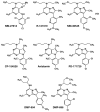Progress in corticotropin-releasing factor-1 antagonist development
- PMID: 20206287
- PMCID: PMC2864802
- DOI: 10.1016/j.drudis.2010.02.011
Progress in corticotropin-releasing factor-1 antagonist development
Abstract
Corticotropin releasing factor (CRF) receptor antagonists have been sought since the stress-secreted peptide was isolated in 1981. Although evidence is mixed concerning the efficacy of CRF(1) antagonists as antidepressants, CRF(1) antagonists might be novel pharmacotherapies for anxiety and addiction. Progress in understanding the two-domain model of ligand-receptor interactions for CRF family receptors might yield chemically novel CRF(1) receptor antagonists, including peptide CRF(1) antagonists, antagonists with signal transduction selectivity and nonpeptide CRF(1) antagonists that act via the extracellular (rather than transmembrane) domains. Novel ligands that conform to the prevalent pharmacophore and exhibit drug-like pharmacokinetic properties have been identified. The therapeutic utility of CRF(1) antagonists should soon be clearer: several small molecules are currently in Phase II/III clinical trials for depression, anxiety and irritable bowel syndrome.
Copyright 2010 Elsevier Ltd. All rights reserved.
Similar articles
-
Don't stress about CRF: assessing the translational failures of CRF1antagonists.Psychopharmacology (Berl). 2017 May;234(9-10):1467-1481. doi: 10.1007/s00213-017-4556-2. Epub 2017 Mar 7. Psychopharmacology (Berl). 2017. PMID: 28265716 Free PMC article. Review.
-
Corticotropin releasing factor receptor antagonists for major depressive disorder.Expert Opin Investig Drugs. 2011 Apr;20(4):519-35. doi: 10.1517/13543784.2011.565330. Expert Opin Investig Drugs. 2011. PMID: 21395482 Review.
-
Development of CRF1 receptor antagonists as antidepressants and anxiolytics: progress to date.CNS Drugs. 2006;20(11):887-96. doi: 10.2165/00023210-200620110-00002. CNS Drugs. 2006. PMID: 17044726 Review.
-
Small molecule antagonists of the corticotropin releasing factor (CRF) receptor: recent medicinal chemistry developments.Curr Top Med Chem. 2008;8(6):506-20. doi: 10.2174/156802608783955665. Curr Top Med Chem. 2008. PMID: 18397172 Review.
-
Structure and Function of Small Non-Peptide CRF Antagonists and their Potential Clinical Use.Curr Mol Pharmacol. 2017;10(4):270-281. doi: 10.2174/1874467209666161101144155. Curr Mol Pharmacol. 2017. PMID: 27809751 Review.
Cited by
-
Behavioral, biological, and chemical perspectives on targeting CRF(1) receptor antagonists to treat alcoholism.Drug Alcohol Depend. 2013 Mar 1;128(3):175-86. doi: 10.1016/j.drugalcdep.2012.12.017. Epub 2013 Jan 5. Drug Alcohol Depend. 2013. PMID: 23294766 Free PMC article. Review.
-
Scaffold Repurposing Reveals New Nanomolar Phosphodiesterase Type 5 (PDE5) Inhibitors Based on Pyridopyrazinone Scaffold: Investigation of In Vitro and In Silico Properties.Pharmaceutics. 2022 Sep 15;14(9):1954. doi: 10.3390/pharmaceutics14091954. Pharmaceutics. 2022. PMID: 36145702 Free PMC article.
-
Corticotropin releasing factor: a key role in the neurobiology of addiction.Front Neuroendocrinol. 2014 Apr;35(2):234-44. doi: 10.1016/j.yfrne.2014.01.001. Epub 2014 Jan 20. Front Neuroendocrinol. 2014. PMID: 24456850 Free PMC article. Review.
-
Novel therapeutic strategies for alcohol and drug addiction: focus on GABA, ion channels and transcranial magnetic stimulation.Neuropsychopharmacology. 2012 Jan;37(1):163-77. doi: 10.1038/npp.2011.216. Epub 2011 Oct 26. Neuropsychopharmacology. 2012. PMID: 22030714 Free PMC article. Review.
-
Probing for Neuroadaptations to Unpredictable Stressors in Addiction: Translational Methods and Emerging Evidence.J Stud Alcohol Drugs. 2017 May;78(3):353-371. doi: 10.15288/jsad.2017.78.353. J Stud Alcohol Drugs. 2017. PMID: 28499100 Free PMC article. Review.
References
-
- Vale W, et al. Characterization of a 41-residue ovine hypothalamic peptide that stimulates the secretion of corticotropin and beta-endorphin. Science. 1981;213:1394–1397. - PubMed
-
- Bale TL, Vale WW. CRF and CRF receptors: role in stress responsivity and other behaviors. Annu Rev Pharmacol Toxicol. 2004;44:525–557. - PubMed
-
- Heinrichs SC, Koob GF. Corticotropin-releasing factor in brain: a role in activation, arousal, and affect regulation. J Pharmacol Exp Ther. 2004;311:427–440. - PubMed
-
- Zorrilla EP, et al. Anti-CRF. In: Fink H, editor. Encyclopedia of Stress. A–E. 2. Vol. 1. Elsevier; 2007. pp. 206–214.
Publication types
MeSH terms
Substances
Grants and funding
LinkOut - more resources
Full Text Sources
Other Literature Sources


